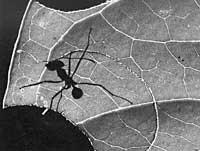Ants in telecommunications
2000/09/01 Elhuyar Zientzia Iturria: Elhuyar aldizkaria
Eric Bonabeu, a biologist and telecommunications engineer at the Santa Fe Institute in California, has unified his two professions by applying ant colony behaviors to telecommunications networks.
Ants, working, leave a pheromone mark on each trip back and forth, allowing them to follow one another. When one of the ants finds a shorter path to the food source, the displacement is faster, the pheromone footprint is reinforced and the other ant attracts its way. In this way the pheromone footprint is further strengthened and the number of ants that will work on the new path is constantly increased. But the ants in a row do not stop looking for paths and if the elder is blocked, they will begin to walk through them.
Bonabeu has adapted this same strategy to telecommunications networks (internet, telephone line, etc. ). The virtual relatives of ants are constantly looking for new ways to use the direct when it is blocked or becomes too slow. In addition, he made a second useful observation for robots: when a group of ants transport a large object, they do not communicate with each other. Instead, they seek at all times the balance of the object.
Bonabeu has applied this strategy to robots and has managed to deliver packaging to each other without any communication. Observation of ant colonies can therefore be of great use in this age of telecommunications.

Gai honi buruzko eduki gehiago
Elhuyarrek garatutako teknologia





